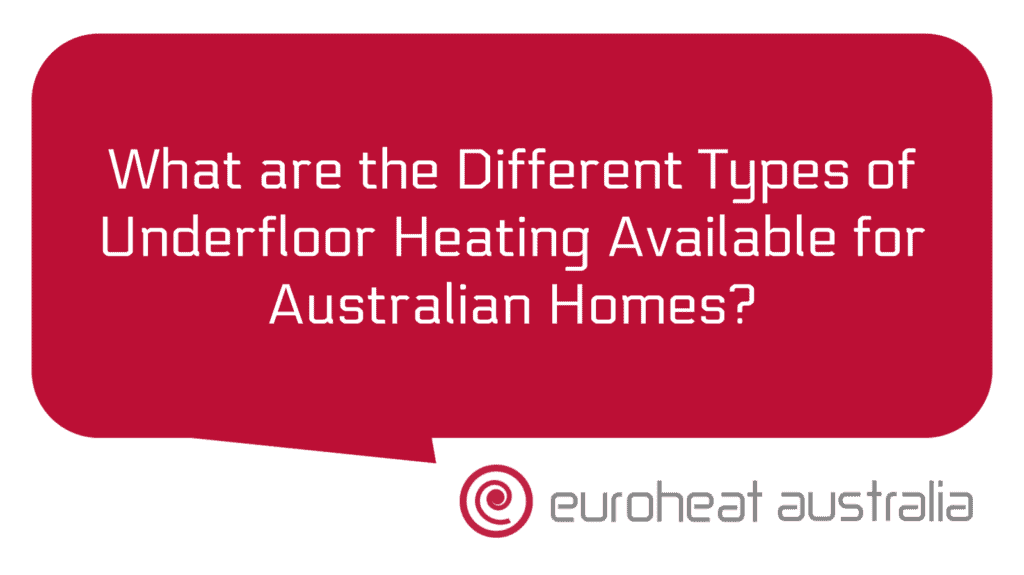When it comes to heating your home in WA, you’ve got options. Two of the most popular choices are:
1️⃣ Hydronic floor heating – a system that gently warms your home from the ground up using heated water in pipes under your floors.
2️⃣ Ducted reverse-cycle heating – a system that blows warm air through vents in your ceiling.
Both systems can keep your home warm, but they work very differently—and those differences affect your comfort, energy bills, and long-term costs.
So, which one is better? Let’s compare them side by side so you can make the best choice for your home.
1. Comfort – How Do They Feel in Your Home?
At the end of the day, heating isn’t just about temperature—it’s about how your home feels.
✅ Hydronic Floor Heating:
✔ Provides gentle, even warmth from the floor up.
✔ No cold spots or temperature fluctuations.
✔ Doesn’t blow air around—feels more natural.
✔ No noise, fans, or dry air.
❌ Ducted Reverse-Cycle Heating:
🚫 Blows hot air from ceiling vents, so warmth collects near the ceiling first.
🚫 Can cause hot and cold spots, depending on vent placement.
🚫 Turns on and off frequently, leading to temperature fluctuations.
🚫 Can feel dry and uncomfortable, especially in winter.
🔹 Winner: Floor heating provides a more natural, stable, and comfortable warmth.
2. Running Costs – Which One is Cheaper to Use?
If you’re choosing a heating system, long-term energy costs matter. So which one is cheaper to run?
💰 Average daily running costs for a 200m² home:
| System Type | Daily Cost | Monthly Cost | Annual Cost |
|---|---|---|---|
| Hydronic Floor Heating (Heat Pump) | $1 – $2 | $30 – $60 | $400 – $700 |
| Ducted Reverse-Cycle Heating | $5 – $7 | $150 – $210 | $1,800 – $2,500 |
🚨 Ducted heating is 3–5 times more expensive to run than hydronic floor heating.
🔹 Why is floor heating cheaper?
✔ Water transfers heat more efficiently than air.
✔ No heat loss through ductwork.
✔ Heat is stored in the slab, so less energy is needed to maintain warmth.
✔ When paired with solar power, running costs can be close to zero.
🔹 Winner: Floor heating—up to 75% cheaper to run.
3. Energy Efficiency – Which One Uses Less Power?
WA homeowners are becoming more energy-conscious, looking for systems that deliver maximum comfort with minimum energy use.
✅ Hydronic Floor Heating (Heat Pump):
✔ Uses low-temperature water (35–45°C) instead of heating air to 60–70°C.
✔ A heat pump is up to 500% efficient (produces 5x more heat than the energy it consumes).
✔ Works perfectly with solar panels, reducing reliance on grid electricity.
❌ Ducted Reverse-Cycle Heating:
🚫 Works by heating and blowing air, which requires far more energy.
🚫 Loses up to 30% of heat through duct leaks in the roof space.
🚫 Uses on-off cycling, which increases power consumption.
🔹 Winner: Floor heating—it uses far less energy for the same level of warmth.
4. Air Quality – Which One is Healthier?
Your heating system doesn’t just affect warmth—it also affects the air you breathe.
✅ Hydronic Floor Heating:
✔ No air circulation, so no dust, allergens, or dry air.
✔ Perfect for asthma and allergy sufferers.
✔ No noisy fans—completely silent operation.
❌ Ducted Reverse-Cycle Heating:
🚫 Blows dust, allergens, and bacteria around the home.
🚫 Can dry out the air, leading to throat irritation and discomfort.
🚫 Noisy operation—you’ll hear fans turning on and off all day.
🔹 Winner: Floor heating—better for air quality, health, and peace & quiet.
5. Maintenance & Lifespan – Which One Lasts Longer?
If you’re spending thousands on a heating system, you want it to last a long time with minimal maintenance.
✅ Hydronic Floor Heating:
✔ Pipes have a 100+ year lifespan.
✔ Heat pumps last 15–25 years with minimal servicing.
✔ No moving parts under the floor, meaning nothing to break down.
❌ Ducted Reverse-Cycle Heating:
🚫 Ducted systems need filter cleaning and fan maintenance every 6–12 months.
🚫 Ducts collect dust, requiring regular servicing.
🚫 Systems typically last 10–15 years before needing replacement.
🔹 Winner: Floor heating—lasts longer and requires almost no maintenance.
6. Installation Cost – Which One Costs More Upfront?
A well-designed heating system is an investment, and while floor heating costs more to install, it saves you thousands in energy bills over time.
💰 Upfront installation costs for a 200m² home:
| System Type | Installation Cost |
|---|---|
| Ducted Reverse-Cycle Heating | $20,000 – $25,000 |
| Hydronic Floor Heating (Heat Pump) | $40,000 – $50,000 |
🚨 Ducted heating is cheaper upfront, but much more expensive to run long-term.
🔹 Break-even point:
- By year 10, a hydronic system will have paid for itself in energy savings.
- By year 20, a homeowner using ducted heating will have spent $20,000+ more than someone with floor heating.
🔹 Winner: Ducted heating is cheaper upfront, but floor heating wins in the long run.
Final Verdict – Which Heating System is Best for You?
| Category | Hydronic Floor Heating | Ducted Heating |
|---|---|---|
| Comfort | ✅ Gentle, even warmth | 🚫 Hot air rises, causing cold spots |
| Running Cost | ✅ $400–$700 per year | 🚫 $1,800–$2,500 per year |
| Energy Efficiency | ✅ 75% lower energy use | 🚫 High power consumption |
| Air Quality | ✅ No dust, no noise | 🚫 Blows allergens & dries air |
| Lifespan & Maintenance | ✅ 100+ years for pipes | 🚫 Frequent servicing & repairs |
| Installation Cost | 🚫 Higher upfront ($40K–$50K) | ✅ Lower upfront ($20K–$25K) |
Which One is Right for You?
💡 Choose Ducted Heating if:
✔ You want a cheaper upfront cost.
✔ You don’t mind higher running costs over time.
✔ You’re okay with warm air coming from ceiling vents.
💡 Choose Hydronic Floor Heating if:
✔ You want the most comfortable, consistent warmth.
✔ You care about low energy bills and long-term savings.
✔ You want a silent, dust-free, and low-maintenance system.
🚀 Our recommendation? If you’re building a new home and plan to stay for years, floor heating is the smarter investment.
💬 Thinking about floor heating for your home?
At Euroheat Australia, we design and install high-efficiency hydronic heating systems that keep your home warm, comfortable, and cost-effective for decades.
📞 Call us today or request a free consultation online!





